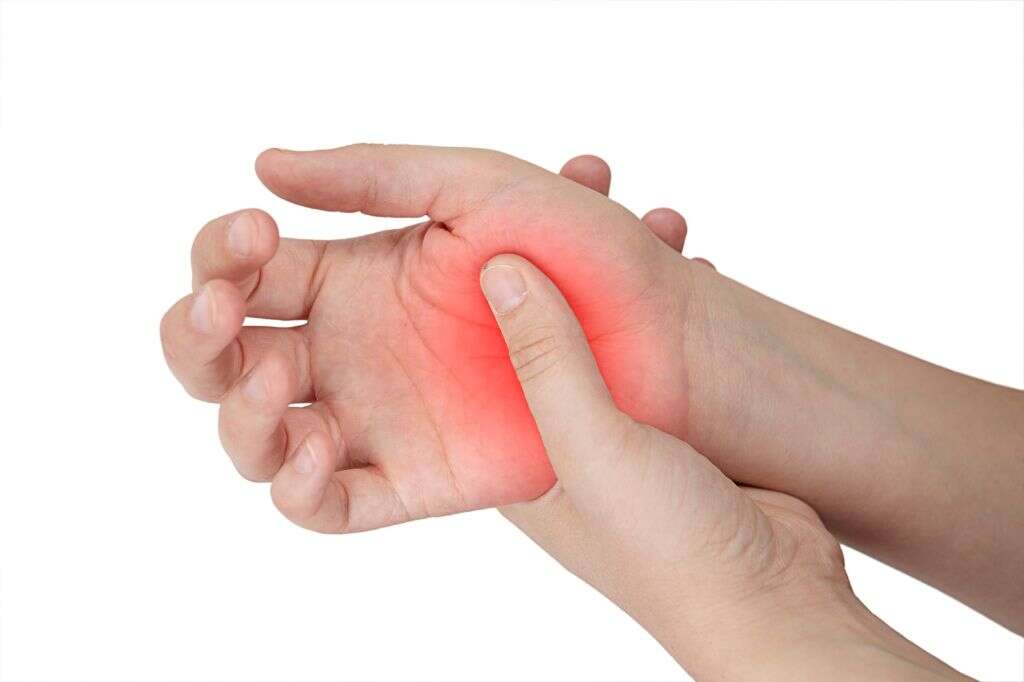What Is Cubital Tunnel Syndrome?
A sudden impact to the inside of your elbow can cause symptoms of pain and tingling that travel all the way down your arm into your fingers. People often describe this as hitting your “funny bone.” However, it is not a bone that is responsible for unpleasant sensations but the ulnar nerve. Extending from the side of your neck, the ulnar nerve travels across your shoulder, down through your arm, and into your hand. Also known as ulnar neuropathy, cubital tunnel syndrome results from compression of your ulnar nerve at your elbow.
It can be easy to confuse cubital tunnel syndrome with carpal tunnel syndrome. The names are similar, and each involves pressure on one of the nerves that provide feeling to the hand. Carpal tunnel syndrome is different in that the compression occurs at the wrist and affects the median nerve. Therefore, although the symptoms may be similar, carpal tunnel syndrome and cubital tunnel syndrome each affect different fingers.

1. Prevalence
Most people have probably experienced temporary symptoms of ulnar nerve compression at some point in their lives. You may have experienced feelings of numbness and tingling in your hand after leaning your elbow on a hard surface for some time. Once you moved your elbow and relieved the pressure, the symptoms probably went away. Cubital tunnel syndrome occurs when the ulnar nerve is under constant or repetitive pressure and the symptoms do not resolve on their own.
Cubital tunnel syndrome is considerably less prevalent than carpal tunnel syndrome. For every 100,000 people, there are approximate 24.7 cases of ulnar neuropathy diagnosed per year. Though carpal tunnel more often affects women, cubital tunnel syndrome is nearly twice as common in men. It may be difficult to gauge the true incidence of ulnar neuropathy, however, because the symptoms can mimic other conditions of the elbow.

2. Symptoms
Most people first notice symptoms of cubital tunnel syndrome in the affected hand. These typically involve numbness, tingling, and/or pain, especially in the ring and small fingers. You may also experience a lack of grip strength. Moving your fingers may become more difficult, and you may have trouble manipulating small objects or performing activities that require manual dexterity, such as playing the piano.
You may also experience symptoms in the forearm or elbow. Rather than numbness or tingling, these typically take the form of a dull ache. Pain in your elbow will occur along the inside, i.e., the part that is closest to your body when you stand with your hands at your side with the palms facing front. The pain at your elbow may be similar to that caused by medial epicondylitis, more commonly known as golfer’s elbow.

3. Causes
There is little in the way of soft tissue at the elbow to protect or cushion the ulnar nerve. It is very close to the skin surface, making it vulnerable to pressure that is frequent or prolonged. The ulnar nerve can also become irritated if it snaps back and forth across the bone as the elbow moves.
Keeping the arm bent causes the ulnar nerve to stretch across the surface of the bony projection at the elbow. This can put pressure on the nerve and result in ulnar neuropathy. Some people experience symptoms at night because they sleep with their elbows bent and the nerve gets stretched for six to eight hours out of every 24. Sometimes, however, it is impossible to determine exactly what is causing cubital tunnel syndrome.

4. Risk Factors
Your activities at work or play may put you at greater risk for developing cubital tunnel syndrome. For example, it is common in baseball pitchers because of the forceful, repetitive flexion and extension of their elbows as they hurl the ball toward home plate. People who spend a lot of time driving are at greater risk because they spend a lot of time with their elbows bent and sometimes rest them on an armrest or an open window. Cubital tunnel syndrome is also fairly common among people who spend a lot of time talking on the phone or typing on a computer.
Some underlying medical conditions can also put you at greater risk for cubital tunnel syndrome. Diabetes, for example, can cause damage to peripheral nerves and is more commonly associated with cubital tunnel syndrome than any other condition. Arthritis rarely affects the elbow, but when it does, it can cause ulnar neuropathy. If you have a personal history of past fracture or dislocation of the elbow, that can also put you at greater risk.

5. Complications
If cubital tunnel syndrome is left untreated, it can cause wasting of the muscles of the hand. The fingers may curl into a claw-like deformity. Even if there is no deformity, the usefulness of the hand may be severely diminished.
Prolonged ulnar neuropathy may also cause permanent damage to the nerve itself. Even if the worst of your symptoms subside, you may still experience decreased sensation in the hand. As a result of these complications, you may no longer be able to type or perform other tasks requiring fine motor skills, at least not as quickly or effectively as you used to.

6. Diagnosis
To avoid permanent damage to the muscles and nerves, it is important to see a doctor if your symptoms of cubital tunnel syndrome last more than a few weeks or interfere with your usual activities. The doctor will probably start with a physical examination. To see if different positions provoke your symptoms, the doctor may gently move your elbow, wrist, neck, and shoulder and check the strength and sensation of your fingers and hand. He or she will probably also examine the ulnar nerve directly, checking whether it tends to slide out of normal position and tapping it to see if it is unusually sensitive.
To confirm a diagnosis of cubital tunnel syndrome and rule out other conditions of the elbow, your doctor may also order nerve tests. An electromyogram uses electrical stimulation to quantify the function of your muscles and nerves, and a nerve conduction test measures the speed at which neural signals travel. These tests are often performed together. An X-ray is usually not very useful at diagnosing cubital tunnel syndrome but may help identify musculoskeletal issues that could be contributing to symptoms, such as arthritis or bone spurs.

7. Treatment
The first step in treating cubital tunnel syndrome is usually to avoid activities that cause or provoke the symptoms, giving the ulnar nerve a chance to rest and heal. Steroid injections are generally effective at reducing inflammation but are rarely used for cubital tunnel syndrome because of the risk that they could cause further damage to the nerve tissue. If the symptoms are relatively new, your doctor may recommend non-steroidal anti-inflammatory medications instead, such as naproxen or ibuprofen. Icing the elbow may also help reduce inflammation. Some doctors recommend nerve gliding exercises, but not everyone is convinced of their effectiveness.
If symptoms are severe or do not respond to other treatments, surgery may be necessary to treat ulnar neuropathy. One of the most common surgeries used to treat cubital tunnel syndrome is an ulnar nerve transposition. This involves moving the ulnar nerve from its normal position along the back of the elbow around to the front. Other surgical options include medial epicondylectomy, which involves removing the bony ridge of the elbow that stretches the nerve, or cubital tunnel release, which relieves the compression and gives the nerve more room.

8. Recovery
Most patients see gradual improvement of their symptoms with conservative treatment measures, such as rest, ice, medication, and exercise. The pace of your recovery may depend on how serious your symptoms were to begin with and how long you experienced symptoms before seeking treatment.
Follow surgery, your doctor may require you to immobilize your elbow in a splint for a period of time. Usually, this will be a matter of weeks, but the exact duration may depend on the type of procedure you had. Following immobilization, your arm may be stiff and weak. Physical therapy may be necessary to restore your motion and strength.

9. Prognosis
Whether you treat it conservatively or surgically, your chances of recovering fully from cubital tunnel syndrome are best if you seek treatment early. If you wait too long, the resulting damage to muscles or nerves may be too extensive to heal on its own.
Though surgery is not always recommended to treat cubital tunnel syndrome, most patients who do have surgery experience good results. The success rates are similar for all procedures used to treat ulnar neuropathy.

10. Prevention
You can decrease your chances of developing cubital tunnel syndrome by modifying your activities to avoid those that may put pressure or strain on the ulnar nerve. For example, if your symptoms are work-related due to typing or talking on the phone, you can make changes to your work station so that your elbows are above the surface of your desk and try wearing a headset rather than holding the phone up to your ear.
Improving the strength and flexibility of your arms may also help to prevent cubital tunnel syndrome. Talk to your doctor, therapist, or trainer for examples of exercises that would be helpful. Be sure to warm up before activities that could strain your ulnar nerve.












